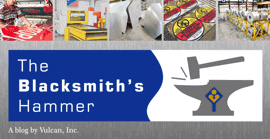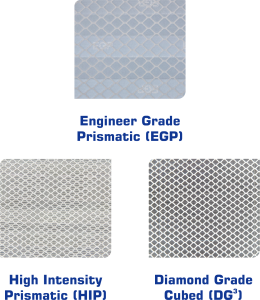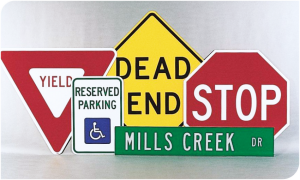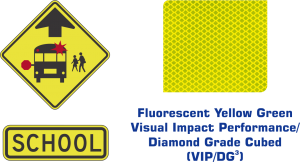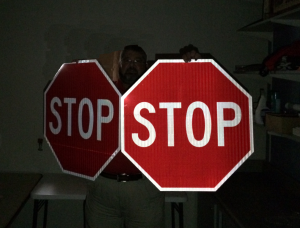Since the advent of reflective sheeting in the 1930s (by 3M Corporation), scientific research has advanced this product component primarily used for highway signs, steadily improving brightness and visibility over time. First, Engineer Grade sheeting was introduced into the marketplace, followed by High Intensity and Diamond Grade. 3M has developed all grades of sheeting with prismatic technology, providing brighter, longer-lasting signs for the motoring public.
When determining which sheeting type to utilize in highway sign fabrication, several concerns come to mind. Will the sheeting meet the specs required for that particular type sign? What about longevity in the field?
– Engineer Grade Prismatic (EGP) has no warranty, and has a life expectancy of five to seven years.
– High Intensity Prismatic (HIP) comes with a 10 year warranty. HIP Type 4 meets all mandated FHWA retroreflectivity standards in all colors for ground mount signs.
– Diamond Grade Cubed (DG3) provides superior performance and has a 12 year warranty.
– School signs and unsignalized pedestrian crosswalks shall be Fluorescent Yellow Green (FYG).
With baby boomers aging, there has been a push for bigger, brighter signs on the road to serve this largest segment of the population. This push has accelerated the advancement of technology in sheeting research and development. Angularity and retroreflectivity are the key elements explored here. This can be defined by…
Retroreflectivity simply refers to the property of a traffic sign to reflect light back to the driver to increase nighttime visibility. Retroreflectiviity degrades over time, necessitating the need for systematic replacement of signs to maintain the retroreflectivity standards established and required by FHWA.
Angularity refers primarily to Entrance Angle, which is the angle of the sign relative to the vehicle when the sign is viewed by the driver. The angle at which a sign is seen affects its visibility, especially at night. The more angled a reflective sign is from the driver’s perspective, the lower the amount of retroreflected light reaching the driver and the less bright the sign appears. The Entrance Angle varies according to the driver’s distance from the sign, so the reflective sheeting must be able to perform well along the whole approach to the sign.
As seen in this photo, angularity greatly affects the visibility of a sign under nighttime conditions.
 Vulcan Corporate
Vulcan Corporate
 Sheets, Blanks & Extrusions
Sheets, Blanks & Extrusions
 Custom Stamping & Laser Cutting
Custom Stamping & Laser Cutting
 Traffic Control & Commercial Signage
Traffic Control & Commercial Signage
 Aluminum Coil in Multiple Tempers, Gauges & Widths
Aluminum Coil in Multiple Tempers, Gauges & Widths
 Utility Signs, Markers & Related Products
Utility Signs, Markers & Related Products






